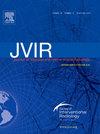Optimal Timing of Percutaneous Cholecystostomy across Different Grades of Acute Cholecystitis: A Retrospective Cohort Study
IF 2.6
3区 医学
Q2 PERIPHERAL VASCULAR DISEASE
Journal of Vascular and Interventional Radiology
Pub Date : 2025-04-14
DOI:10.1016/j.jvir.2025.04.002
引用次数: 0
Abstract
Purpose
To investigate the effect of percutaneous cholecystostomy (PC) tube placement timing on clinical outcomes in patients with Grade I–III acute cholecystitis (AC) who did not undergo surgery.
Materials and Methods
This retrospective single-center cohort study included patients with AC who initially underwent PC between October 2018 and December 2022. The following outcomes were analyzed: (a) rate of all-cause in-hospital mortality (IHM), (b) length of hospital stay (LOS), (c) duration of intensive care unit stay, and (d) rate of recurrence, which were correlated with clinical and procedural characteristics, disease severity, and PC timing. Subgroup analysis was then performed to investigate the effects of drainage timing across different severity grades.
Results
This study included 183 patients. Severity grade, drainage timing, age, and Charlson Comorbidity Index score significantly influenced LOS (P < .001, P = .002, P = .001, and P = .010, respectively). In the subgroup analysis, PC performed within 24 hours in patients with Grade II AC significantly shortened LOS (median, 7.0 vs 10.0 days; P = .028). In patients with Grade III AC, PC performed after 6 hours significantly extended LOS (median, 19.0 vs 9.0 days; P = .010). Multivariate analysis indicated that IHM was associated with severity grade and age (P = .009 and P = .008, respectively) but not drainage timing.
Conclusions
Urgent drainage may be unnecessary for patients with Grade I or II AC. However, a reduction in LOS was observed for patients with Grade III AC who underwent PC within 6 hours and those with Grade II AC who underwent PC within 24 hours after admission.

不同级别急性胆囊炎患者经皮胆囊造瘘的最佳时机:一项回顾性队列研究。
目的:本研究探讨经皮胆囊造瘘(PC)置管时机对未行手术治疗的I ~ III级急性胆囊炎(AC)患者临床预后的影响。材料和方法:本回顾性单中心队列研究纳入了2018年10月至2022年12月期间首次接受PC治疗的AC患者。以下结果分析包括全因住院死亡率(IHM)、住院时间(LOS)、重症监护病房(ICU)住院时间和复发率,这些指标与临床和手术特征、疾病严重程度和PC时间相关。然后进行亚组分析,以调查不同严重程度的引流时间的影响。结果:本研究纳入183例患者。严重程度、引流时间、年龄和Charlson合并症指数(CCI)评分显著影响LOS (p分别为0.000、0.002、0.001和0.010)。在亚组分析中,II级AC患者在24小时内行PC可显著缩短LOS(中位7.0 vs 10.0天,p = 0.028)。在III级AC患者中,PC在6小时显著延长LOS后进行(中位19.0 vs. 9.0天,p = 0.010)。多因素分析显示,IHM与严重程度和年龄相关(P值分别为0.009和0.008),但与引流时间无关。结论:对于I级或II级AC患者可能不需要紧急引流。然而,在入院后6小时内进行PC的III级AC患者和在入院后24小时内进行PC的II级AC患者的LOS减少。
本文章由计算机程序翻译,如有差异,请以英文原文为准。
求助全文
约1分钟内获得全文
求助全文
来源期刊
CiteScore
4.30
自引率
10.30%
发文量
942
审稿时长
90 days
期刊介绍:
JVIR, published continuously since 1990, is an international, monthly peer-reviewed interventional radiology journal. As the official journal of the Society of Interventional Radiology, JVIR is the peer-reviewed journal of choice for interventional radiologists, radiologists, cardiologists, vascular surgeons, neurosurgeons, and other clinicians who seek current and reliable information on every aspect of vascular and interventional radiology. Each issue of JVIR covers critical and cutting-edge medical minimally invasive, clinical, basic research, radiological, pathological, and socioeconomic issues of importance to the field.

 求助内容:
求助内容: 应助结果提醒方式:
应助结果提醒方式:


